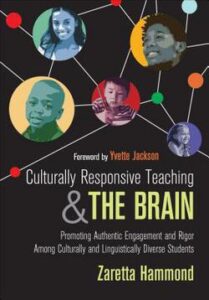Culturally Responsive Teaching and The Mind: Selling Reliable Engagement and Rigor Between Culturally and Linguistically Numerous Pupils
By Zaretta Hammond
(Corwin, 2015 – Master much more)
Reviewed by Monthly bill Ivey
 Culturally Responsive Instructing and the Mind has become one particular of the better acknowledged go-to texts for lecturers interested in carrying their fairness do the job further and examining the mindset essential to place that work to practice in the classroom. And deservedly so.
Culturally Responsive Instructing and the Mind has become one particular of the better acknowledged go-to texts for lecturers interested in carrying their fairness do the job further and examining the mindset essential to place that work to practice in the classroom. And deservedly so.
 Previous summer months I was one of the facilitators of NENTS 2., a four-day summer time workshop for early profession teachers presented by the Connecticut Association of Unbiased Colleges and the Affiliation of Independent Colleges of New England, and we essential the textual content as progress reading for all our contributors.
Previous summer months I was one of the facilitators of NENTS 2., a four-day summer time workshop for early profession teachers presented by the Connecticut Association of Unbiased Colleges and the Affiliation of Independent Colleges of New England, and we essential the textual content as progress reading for all our contributors.
We benefit Zaretta Hammond’s mixture of a distinct clarification of brain-centered learning from a cultural point of view and a distinct description of how it appears to be in motion. Though we in NENTS 2. get the job done with early profession instructors, I located the guide on 1st study to also be beneficial to me as a late-mid occupation trainer, and I believe it can be valuable to teachers of all ages and encounters.
The book’s composition
1. Introduction
2. Setting up Recognition and Awareness
a. Climbing Out of the Hole
b. What is Tradition Bought to Do with It?
c. This Is Your Mind on Tradition
d. Getting ready to Be a Culturally Responsive Practitioner
3. Developing Finding out Partnerships a-c
a. Setting up the Basis of Learning Partnerships
b. Creating Alliance in the Mastering Partnership
c. Shifting Academic Mentality in the Learning Partnership
4. Making Intellective Capability
a. Information Processing to Construct Intellective Ability
b. Making a Culturally Responsive Community for Finding out
5. Epilogue
6. Glossary
7. References and Further Looking through
8. Index
Every single chapter finishes with 3 bulleted lists: a chapter summary, an invitation to inquiry, and assets to go further.
Consciousness, Discovering Partnerships, Data Processing, and Neighborhood
The very first chapter introduces Zaretta Hammond’s All set for Rigor framework: Awareness, Discovering Partnerships, Information Processing, and Group of Learners and Learning Surroundings (pp.17-20). In describing the framework, Hammond makes the subsequent critical details (among the other individuals!):
- In developing recognition, we want to recognize how the brain learns, know and very own our individual cultural lenses, and know and understand the 3 concentrations of tradition.
- We need to rethink student and trainer interactions as a partnership, supporting each individual scholar create a feeling of self-efficacy.
- We want to integrate oral traditions with other techniques of info processing, and supply students with reliable opportunities to approach articles.
- And we need to make certain pupils sense harmless and have voice and agency. (Hammond, p.17)
By way of the e book Hammond develops each of these factors in higher detail, which include a in depth description of the mind and how it capabilities. At the close of Chapter 1, we are invited to replicate on how our universities are addressing the requirements of lower-undertaking pupils of color, how we personally assistance pupils in turning into unbiased learners, and how we and our colleagues can ‘operationalize’ the concepts of culturally responsive training (Hammond, p.20).
I found each individual of these reflection factors to be useful not just as a individual test on what my demands and individuals of my university really are, but also as a way of relocating a lot of her data into longer phrase storage.
Seeking into Individualistic and Collectivist Cultures
I also discovered specifically handy – both of those for myself and for the early occupation instructors with whom I was doing work – the details on individualism and collectivism in chapter 2 (pp.25-28), and the section on “Becoming a Warm Demander” in Chapter 6 (pp.97-99).
Examining far more deeply the traits of individualistic cultures (this sort of as the United States) and collectivist cultures (such as South Korea) assisted me to have an understanding of extra totally the roots of quite a few of the cultural discrepancies I see in my faculty, and outside of.
Wanting at the chart of qualities of instructors who may be classified as warm demanders, technocrats, sentimentalists, and elitists assisted me face up to areas of my teaching personality that may well, nonetheless unintentionally, undermine my efficiency and feel about what measures I could just take.
Neuroscience and Culture
Each individual chapter in this e-book is handy – packed with info about neuroscience and what a actually culturally responsive method seems like and why it is so efficient. Culturally Responsive Teaching and the Brain incites academics of all ages to reflect on how finest we can help our pupils. No question it is so usually suggested.
Monthly bill Ivey (he/any) is Center Faculty Dean and teaches Humanities 7, Rock Band, and Educational Skills at Stoneleigh-Burnham School, a gender inclusive ladies school for grades 7-12 in Western Massachusetts. He also serves on the NELMS Board of the Administrators as an advisor for fairness, inclusion, and social justice, and on the AMLE Equity in Middle Grades Instruction Committee. See Bill’s other MiddleWeb evaluations and article content in this article.






More Stories
Simple Lessons In Never Giving Up
The duality of Agile – E-Learning Provocateur
Hvar Travel Guide | Wander With Wonder